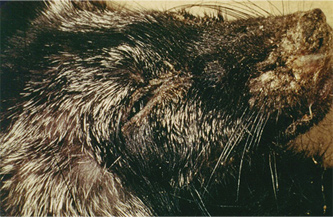Other names: footpad disease, hard pad disease
Description

Image courtesy of Michigan DNR
Canine distemper is a virus that attacks the respiratory, gastrointestinal, and nervous systems in a variety of species. It can affect wildlife such as foxes, wolves, coyotes, raccoons, skunks, mink, river otter, weasels, badgers, and ferrets, as well as domestic animals like dogs. The disease is found worldwide and has been reported as early as the 17th century.
Transmission
The virus is transmitted through direct contact with urine, saliva, feces, and other infected animals' secretions. Young animals are more susceptible to the virus, and cases in wildlife increase in the spring and summer when babies are being born. The virus can survive for long periods of time in the environment if temperatures remain below freezing, but it rarely survives in hot summer and mild winter temperatures long in the soil.
Clinical Signs
Signs of canine distemper may show 10-14 days after infection and include eye and nasal discharge, fever, coughing, lethargy (e.g., low energy or unwillingness to move), reduced appetite, vomiting, diarrhea, and thickened skin on the nose and footpads (hyperkeratosis). As the virus attacks their nervous system, animals develop circling behavior, head tilt, muscle twitches, and seizures. They also may exhibit “chewing gum fits”, which consist of snapping, jaw spasms, and salivation that progresses to seizures. In late stages of illness, wildlife can exhibit fearlessness, aimless wandering, and aggressiveness.
These signs can be concerning and often make people think of rabies, but rabies is uncommon in Indiana’s furbearers like raccoons, skunks, foxes, and coyotes. Distemper is currently the more likely cause if these signs are being seen in an Indiana furbearer.
No illness can be confirmed from physical signs alone. Testing is always needed to confirm a disease. Never approach wild animals, especially if they appear sick, in any way. If you observe an animal displaying signs of distemper, consider contacting a wildlife control operator for assistance. They charge fees but are permitted to provide professional services to people who have conflicts with wildlife.
If you find a dead animal on your property, proceed with caution and avoid handling the animal, if possible. If you must dispose of the animal yourself, wear gloves at all times during that process. Examples of disposal options are double bagging the animal and placing it in a trash receptacle or burying the animal at least 2 feet underground.
Report sick or dead animals at on.IN.gov/sickwildlife.
Wildlife Management Implications
There is no vaccine available to prevent canine distemper in wildlife. There is no cure for distemper once it is contracted, and young animals have higher death rates once sick. Every year, Indiana DNR confirms a few cases of distemper outbreaks, often in raccoons; however, detailed data on infection rates is not known for most species in Indiana. Researchers are working with Indiana DNR to understand canine distemper in gray foxes in Indiana.
Human Health Significance
Canine distemper does not cause illness in people; however, the signs of distemper in wildlife can be similar to those of rabies, which is a fatal viral infection usually transmitted to people via the bite of an infected animal. If you have had contact with an animal that appears to be sick, contact your local county health department. If you are concerned about canine distemper in your pet, contact a veterinarian.

